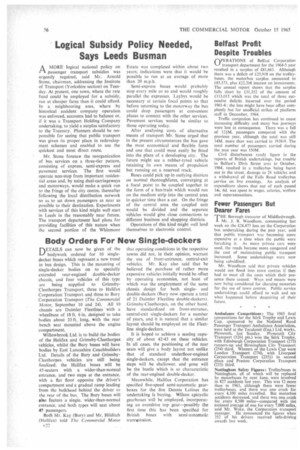Logical Subsidy Policy Needed, Says Leeds Busman
Page 58

If you've noticed an error in this article please click here to report it so we can fix it.
A MORE logical national policy on I-1 passenger transport subsidies was urgently required, said Mr. Arnold Stone, chairman, addressing the Institute of Transport (Yorkshire section) on Tuesday. At present, one town, where the rate fund could be employed for a subsidy, ran at cheaper fares than it could afford. In a neighbouring area, where by historical accident company operation was enforced, accounts had to balance or. if it was a Transport Holding Company undertaking. to yield a surplus satisfactory to the Treasury. Planners should be responsible for seeing that public transport was given its proper place in redevelopment schemes and enabled to use the quickest and most direct route.
Mr. Stone foresaw the reorganization of bus services on a three-tier pattern, consisting of express, semi-express and pavement services. The first would operate non-stop from important residential areas and, by using dual-carriageways and motorways. would make a quick run to the fringe of the city centre, thereafter following the local distribution network so as to set down passengers as near as possible to their destination. Experiments with services of this kind might well start in Leeds in the reasonably near future. The transport department had plans for providing facilities of this nature when the second portion of the Whinmoor Estate was completed within about two years; indications were that it would be possible to run at an average of more than 20 m.p.h.
Semi-express buses would probably stop every mile or so and would roughly parallel the expresses. Laybys would be necessary at certain focal points so that before returning to the motorway the bus could drop passengers at convenient places to connect with the other services. Pavement services would be similar to those operating today.
After analysing costs of alternative means of transport Mr. Stone urged that in the present circumstances the bus gave the most economical and flexible form and one that could most easily be fitted into the plans of a developing city. The future might see a rubber-tyred vehicle retaining its own means of propulsion but running on a reserved track.
Buses could pick up in outlying districts on normal thoroughfares, converging at a focal point to be coupled together in the form of a bus-train which would run on the medium strip into the central area in quicker time than a car. On the fringe of the central area the coupled unit would be divided and the separate vehicles would give close connections to different business and shopping districts.
Operations of this kind might well lend themselves to electronic control.








































































































































